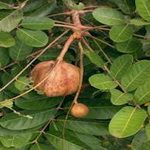| Common Name: |
Andiroba |
| Botanical Name: |
Carapa guaianensis |
| Genus: |
Carapa |
| Family: |
Meliaceae |
| Native Location: |
Tropical Brazil, Columbia, Guyana |
| Height: |
90m (300ft) |
| Parts Used: |
Oil of Nut, Tree Bark, Leaves, Seed oil. |
| Properties: |
Anti-inflammatory, Febrifuge, Antibacterial |
| Medicinal Uses: |
As an anti-inflammatory. The bark and leaves are used internally as a fever reducing, and worm-inhibiting tea, and externally as a wash for skin problems, ulcers and insect bites. It is also used as an antiarthritic, and the oil is ingested for coughs. The bark is antibacterial, the flowers are antitumor, and the heartwood is antifungal.. |
| Considerations for Use: |
Andiroba is used as an oil applied to the skin. It is also used as a base for antiwrinkle creams such as Aveda and Oil of Olay. The fats in the oil transport healing alpha-hydroxy acids and other ingredients as they moisturize and protect the skin. |
| Evidence of Benefit: |
Andiroba oil is an anti-inflammatory due to the presence of compounds known and limonoids. It promotes normal circulation to the skin and relieves pain and swelling. The Northwest Amazons use the bark and leaves for fever-reducing and worm-inhibiting tea, and externally as a wash for skin problems, ulcers, and insect bites, and as an insect repellent. Brazilians use the seed oil as an antiarthritic and anti-inflammatory, while the fruit oil is ingested for coughs.
Tests have confirmed that the bark is antibacterial, the flowers are antitumor, and the heartwood is antifungal. Tests performed at the Museum of Medicinal Plants in Macapa, Brazil, in 1993 suggested that andiroba may have anti-carcinogenic activity. Gelatin capsules containing the oil have been used for the treatment of internal cancers in Brazil.
Benefits of andiroba for specific health conditions include the following:
- Arthritis and Rheumatism: Hot andiroba oil is rubbed into the skin to relieve arthritis and rheumatism.
- Fractures: Andiroba oil is rich in beneficial omega-3 fatty acids. These essential fatty acids are quickly absorbed through the skin and circulated to the area of a fracture. There they offset the production of chemicals that cause inflammation and restrict circulation. Increased circulation reduces swelling, and decreased production of inflammatory chemicals reduces pain.
- Skin Damage from Cuts, Scrapes, and Abrasions; Gonorrhea; Insect Bites; and Psoriasis: Andiroba oil accelerates the healing of skin damage by providing myristic acid, one of the chemical building blocks of an enzyme that links together the proteins that forms the skin's protective outer layer. In treating psoriasis, this chemical also signals skin cells when it is time to stop growing, which prevents scaling. One of the fatty acids found in andiroba oil, linolenic acid, also helps restore a normal life cycle to skin cells. This chemical stops the uncontrolled growth of the pigment-producing cells that cause age spots.
|
| Economic Uses: |
A wash of the seed oil is used an an insect repellant. |
| Bibliography: |
Prescription for Herbal Healing. by Phyllis A Balch, CNC Copyright©2002 Phyllis A. Balch. pp20-21 |

